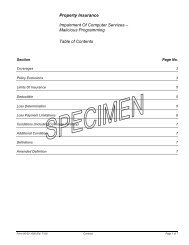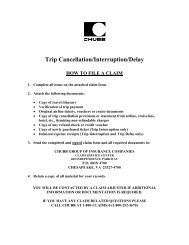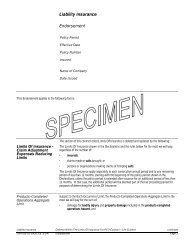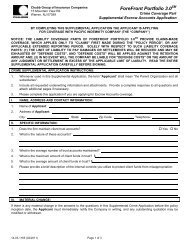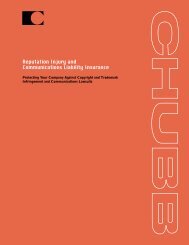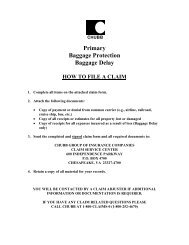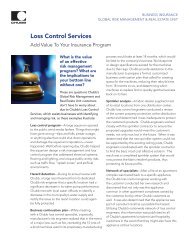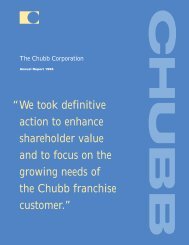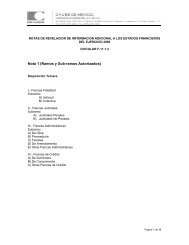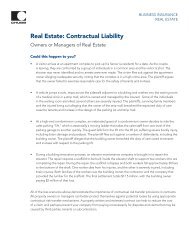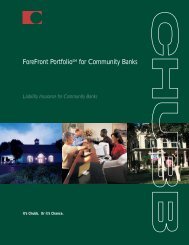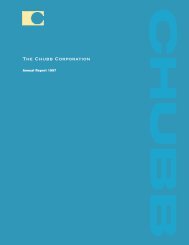Annual Report 2001 - Chubb Group of Insurance Companies
Annual Report 2001 - Chubb Group of Insurance Companies
Annual Report 2001 - Chubb Group of Insurance Companies
Create successful ePaper yourself
Turn your PDF publications into a flip-book with our unique Google optimized e-Paper software.
a dramatic proliferation <strong>of</strong> water damage claims in <strong>2001</strong>,<br />
particularly in Texas, where state mandated policy<br />
language has contributed to broader water damage<br />
coverage. We are closely monitoring the water damage<br />
issue in Texas and in other states where it is becoming a<br />
growing concern. If necessary, we will reduce our<br />
presence in states where we cannot attain rate adequacy<br />
due to regulatory constraints or adverse loss trends.<br />
Commercial <strong>Insurance</strong><br />
1997<br />
1998<br />
1999<br />
2000<br />
<strong>2001</strong><br />
Commercial <strong>Insurance</strong><br />
NET PREMIUMS WRITTEN (in millions <strong>of</strong> dollars)<br />
Multiple Peril<br />
Casualty<br />
Workers’<br />
Compensation<br />
* Excludes Reinstatement Premiums Related to<br />
September 11 Attack<br />
$2,381<br />
$2,340<br />
$2,639<br />
$2,563<br />
$2,496*<br />
Property<br />
Marine<br />
&<br />
Net premiums from commercial insurance increased 7%<br />
in <strong>2001</strong> compared with a 2% decrease in 2000. The<br />
decrease in premiums in 2000 was the result <strong>of</strong> the<br />
strategy we put in place in late 1998 to increase the<br />
pricing in these classes and to not renew underperforming<br />
business where we could not attain price adequacy.<br />
As a result, retention levels were signiÑcantly below<br />
historical levels during 2000. On the business that was<br />
renewed, however, rates increased steadily. Rate<br />
increases remained Ñrm in <strong>2001</strong>. Premiums began to<br />
increase in <strong>2001</strong> as retention levels improved, particularly<br />
in the second half <strong>of</strong> the year. In addition, new<br />
business accelerated in the fourth quarter. Exposure<br />
growth, however, was minimal in <strong>2001</strong> due to the weak<br />
economy.<br />
140%<br />
130%<br />
120%<br />
110%<br />
100%<br />
90%<br />
80%<br />
COMBINED LOSS & EXPENSE RATIOS<br />
1997 1998 1999 2000 <strong>2001</strong>*<br />
1996 1997 1998 1999 2000<br />
* Excludes Impact <strong>of</strong> September 11 Attack<br />
Property & Marine<br />
Casualty<br />
Multiple Peril<br />
Workers’<br />
Compensation<br />
Multiple peril results were near breakeven in <strong>2001</strong><br />
compared with unproÑtable results in 2000 and highly<br />
unproÑtable results in 1999. The improvement in <strong>2001</strong><br />
was principally in the liability component <strong>of</strong> this<br />
business due to a lower frequency and severity <strong>of</strong> losses.<br />
The improvement in 2000 occurred in both the<br />
property and liability components due to a lower<br />
Our commercial insurance business produced underwriting<br />
losses in each <strong>of</strong> the past three years, but has shown<br />
substantial improvement in each succeeding year. The frequency <strong>of</strong> large losses in both the United States and<br />
improvement was due in large part to the cumulative overseas. Results in the property component in 2000<br />
eÅect <strong>of</strong> the pricing increases and more stringent risk also beneÑted from an absence <strong>of</strong> catastrophe losses.<br />
selection in recent years. The combined loss and<br />
Conversely, results in 1999 were adversely aÅected by<br />
expense ratio was 106.1% in <strong>2001</strong> compared with higher catastrophe losses. Catastrophe losses represented<br />
114.2% in 2000 and 120.4% in 1999. 3.0 percentage points <strong>of</strong> the loss ratio for this class in<br />
<strong>2001</strong> and 9.2 percentage points in 1999. There were<br />
Commercial insurance results, particularly in the casualty virtually no catastrophe losses in 2000.<br />
classes, were adversely aÅected in each <strong>of</strong> the past three<br />
years by incurred losses related to asbestos and toxic Results for our casualty business improved considerably<br />
waste claims. Such losses were $61 million in <strong>2001</strong>, $31 in <strong>2001</strong> compared with the prior two years, but<br />
million in 2000 and $47 million in 1999. The higher remained unproÑtable. The improvement in <strong>2001</strong> was<br />
incurred losses in <strong>2001</strong> were the result <strong>of</strong> adverse trends primarily in the automobile component <strong>of</strong> this business<br />
in asbestos related exposure (see ""Loss Reserves''). and, to a lesser extent, the primary liability component.<br />
29



